The Battle of Hampton Roads was probably the most historic battle in the American Civil War. It not only changed naval warfare but, changed it on a global scale and marked the end of the reign of the wooden ship. Naval warfare after the Revolutionary War consisted of large wooden frigates with multiple cannons and powered by wind. The United States was coming into its own but, was still not recognized in the world as a major player because it did have a major navy. In March of 1862, the Battle of Hampton Roads would change the face of naval warfare history and make the United States a premier naval war power throughout the world. Other nations would take notice of the Ironclad warships during the American Civil War and changed how they would conduct naval warfare to the present. Telescope from the Portsmouth Naval Shipyard Museum in Portsmouth, Va
Telescope from the Portsmouth Naval Shipyard Museum in Portsmouth, Va Canon carriage from Sewells Point Battery at the Portsmouth Naval Ship Yard Museum in Portsmouth, Va
Canon carriage from Sewells Point Battery at the Portsmouth Naval Ship Yard Museum in Portsmouth, Va
The Confederacy at the start of 1862 was being cut off from its European allies by naval blockade enforced by the Union. The South needed a way to break the strangle hold and the C.S.S. Virginia would be that answer. The Northern-built Merrimack, a conventional steam frigate, had been salvaged by the Confederates from the Norfolk navy yard and rechristened the Virginia.1
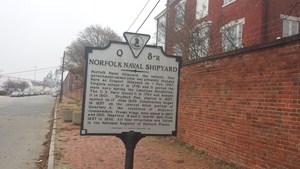 Norfolk Naval Shipyard in Portsmouth, Va. Site were the C.S.S Virginia was built
Norfolk Naval Shipyard in Portsmouth, Va. Site were the C.S.S Virginia was built  Entrance into the Norfolk Naval Shipyard in Portsmouth, Va
Entrance into the Norfolk Naval Shipyard in Portsmouth, Va Replica of the Virginia at the Mariners Museum in Newport News, Va
Replica of the Virginia at the Mariners Museum in Newport News, Va
With her upper hull cut away and armored with iron, this 263-foot masterpiece of improvisation resembled, according to one contemporary source, “a floating barn roof.”2 Once construction was done, the C.S.S. Virginia steamed its way up the James River. From there it would make first contact against the Union blockade on March 8th. Captain Marston of the U.S.S. Roanoke wrote in a report, “The Merrimack was soon discovered passing out by Sewell's Point, standing up toward Newport News, accompanied by several small gunboats”.3
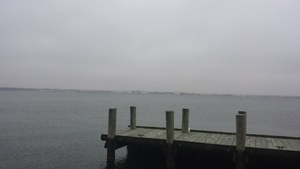 Willoughby spit looking out towards Sewell's Point in Norfolk, Va
Willoughby spit looking out towards Sewell's Point in Norfolk, Va
Many felt the Virginia did not have much of a chance against the bigger Union fleet. The Harper's Weekly wrote, “Great activity is observed by our fleet in the harbor, and should this rebel craft be so intrepid as to undertake so hazardous an expedition, she will find a warm reception”.4 The executive office on board the Virginia states, “In consequence of the wound of Flag-officer Buchanan, it becomes my duty to report that the Virginia left the yard this morning at eleven o'clock, steamed down the river past our batteries, and over to Newport News, where we engaged the frigates Cumberland and Congress and the batteries ashore, and also two large steam-frigates, supposed to be the Minnesota and Roanoke, and a sailing-frigate and several small steamers armed with heavy rifled guns”.5 We sank the Cumberland, and drove the Congress ashore, where she hauled down her colors and hoisted the white flag; but she fired upon us with the white flag flying, wounding Lieutenant Minor and some of our men.6 We again opened fire upon her, and she is now in flames.7 Captain Marston stated, “Between 7 and 8 o'clock we discovered that the rebels had set fire to the Congress, and she continued to burn till 1 o'clock, when she blew up”.8 The Minnesota and the Roanoke were spared the same fate by the cover of darkness. The Virginia continued to wreaked havoc throughout the James River while fears grew in the Union.
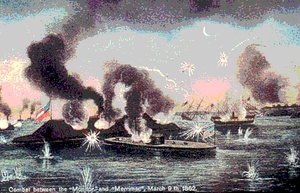 Battle of Hampton Roads (Civil War Project)
Battle of Hampton Roads (Civil War Project) Battle Map (civilwar.org)
Battle Map (civilwar.org)
The Union, already aware of the Confederates plans to build an ironclad, decided to build an ironclad of their own. The Union ironclad Monitor, under the command of Lieutenant John Worden, arrived the same night.9 This 172-foot “Yankee Cheese Box on a raft,” with its water-level decks and armored revolving gun turret, represented an entirely new concept of naval design.10 The Baltimore American gives a vivid description of the Union ironclad. “The Monitor is the reverse of formidable; lying low on the water, with a plain structure amid ship, a small pilot house forward, a diminutive smoke-pipe aft, at a mile's distance she might be taken for a raft, with an army ambulance amid ship”.11 Soon the Monitor would arrive to the battle to take on the Virginia. The Baltimore American states, “About nine o'clock, Ericsson's battery, the Monitor, arrived at the Roads, and upon her performance was felt that the safety of their position in a great measure depended”. 12
 Replica of the U.S.S Monitor at the Mariners Museum in Newport News, Va
Replica of the U.S.S Monitor at the Mariners Museum in Newport News, Va
The two ironclads would meet across Sewell’s Point in their historic battle. “The Merrimac and the Monitor kept on approaching each other, the former waiting until she would choose her distance, and the latter apparently not knowing what to make of her funny-looking antagonist”.13 The first shot from the Monitor was fired when about one hundred yards distant from the Merrimac, and this distance was subsequently reduced to fifty yards, and at no time during the furious cannonading that ensued, were the vessels more than two hundred yards apart.14 At first the fight was very furious, and the guns of the Monitor were fired rapidly and as she carries but two guns, whilst the Merrimac has eight, of course she received two or three shots for every one she gave.15 Finding that her antagonist was much more formidable than she looked, the Merrimac attempted to run her down but, the superior speed and quicker turning qualities of the Monitor enabled her to avoid these shocks, and to give the Merrimac, as she passed, a shot.16 The Monitor with its speed was able to give fits to the Virginia but neither ship was able to make any significant damage. Because of this the Virginia retired back to its shipyard and the battle was a stalemate.
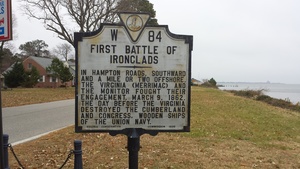 Marker where the battle was visible on Chesapeake Ave in Hampton, Va
Marker where the battle was visible on Chesapeake Ave in Hampton, Va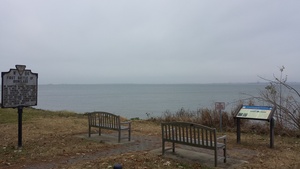 Chesapeake Ave in Hampton, Va
Chesapeake Ave in Hampton, Va
The Virginia’s spectacular success on March 8th had not only marked an end to the day of wooden navies but had also thrilled the South and raised the false hope that the Union blockade might be broken.17 The two ironclads faced off once more, on April 11, 1862, but did not engage, neither being willing to fight on the other’s terms.18 The Union side wanted the encounter to take place in the open sea while, the Virginia, on the other hand, tried unsuccessfully to lure the Monitor into another battle in Hampton Roads harbor.19 On May 9, 1862, following the Confederate evacuation of Norfolk, the Virginia was destroyed by its crew. The Monitor, with 16 crewmen, was lost during a gale off Cape Hatteras, North Carolina, on December 31, 1862.20
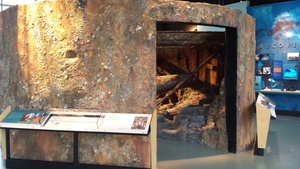 Replica of the Monitor turret on display at the Mariners Museum in Newport News, Va
Replica of the Monitor turret on display at the Mariners Museum in Newport News, Va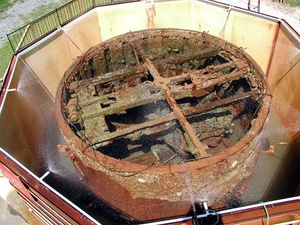 Actual turret being restored at the Mariners Museum in Newport News, Va
Actual turret being restored at the Mariners Museum in Newport News, Va
1 "Encyclopedia Britannica Online, s. v." "Battle of the Monitor and Merrimack". December 02, 2014. http://www.britannica.com/EBchecked/topic/389515/Battle-of-the-Monitor-and-Merrimack.
2 Encyclopedia Britannica Online, s. v. 2014
3 Official Records of the Union and Confederate Navies in the War of the Rebellion. Washington: Government Printing Office, 1898.
4 Tyson, Martha Tyson. "The Illustrated London News." THE CONFEDERATE ACCOUNT OF THE NAVAL FIGHT IN HAMPTON ROADS, April 5, 1862: 344.
8 Official Records of the Union and Confederate Navies in the War of the Rebellion 1898
9 Encyclopedia Britannica Online, s. v. 2014
10 Encyclopedia Britannica Online, s. v. 2014
11 The Rebellion Record: A Diary of American Events. "Baltimore American." 1862: 273-275.
17 Encyclopedia Britannica Online, s. v. 2014
18 Encyclopedia Britannica Online, s. v. 2014
19 Encyclopedia Britannica Online, s. v. 2014


